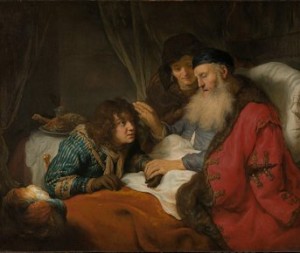"Sparkling light enters from the left" describes Willem Kalf’s paintings perfectly and succinctly. He painted luminous elegant objects peering through the shadowy chiaroscuro of his still life compositions.
Willem Kalf, mentioned in my previous post, Juicy Paint, was born in Rotterdam in 1619, and was known not only for his still life, but also became famous for interiors of farmhouses and peasant kitchens mostly in small format scenes. He captured unusual qualities in mundane objects in a manner unseen by other artists.
Brilliantly, he portrayed on a flat canvas the graduated field of light as it travels back into the depth of a room. The objects nearest you, the viewer's eye, have the brightest light, most intense color, and engaging impasto. As you peer into and behind the focus area the objects become less discernible. One at a time while wandering into that darkness, vases, urns, or elegant compotes appear slowly, looking as if light will be dimmed till morning comes. A captivating stillness draws you, the viewer, in for just one moment of tranquility.
In a painting where the light hits the curve of a silver handle, a rind of an orange, or a Wan-li dish, Kalf was masterful at portraying sparkling luminosity. To me, these areas are the most astonishing and beautiful. Very wet paint loaded with a drying oil was placed, light over dark, to convey dots of glowing, even playful, highlights.
Like notes of music Kalf used point and counterpoint across the surface with sharp and blurred strokes of paint that suggest lumps and cavities. The dark underpaint remains visible with these wet in wet applications.
In order to analize his technique further, think about an object full of texture, say, like the inside of a pomegranate. Now visualize it up close to you, then far away. When it is closest to you all the seeds and ins and outs of the pulp are clear. But when it is moved away from you the vision becomes blurred. The edges are unclear, the seeds are perhaps just a mass shape. This is a major component to Kalf's technique. To make something recede into the background it has less or no texture.
Now think of the same object, except apply this to the color. A bright clear color is in the foreground, and as it goes back in space, the color is lost. Willem Kalf was a true master of this technique and created amazing effects with his brush.
Space also is important in analyzing his paintings. Space, or depth and atmosphere, with few objects surrounded by lots of room, give a feeling of peacefulness. There are areas that arouse and excite, full of color, sharp edges, and texture, then calmly sets your senses down again for a rest in the murky darkness.

If I could have but a thimble full of his skill, I would be a happy woman. I promise to post an image of a Kalf painting at a later date.

Pls revert me on Gold Leaf Application more details